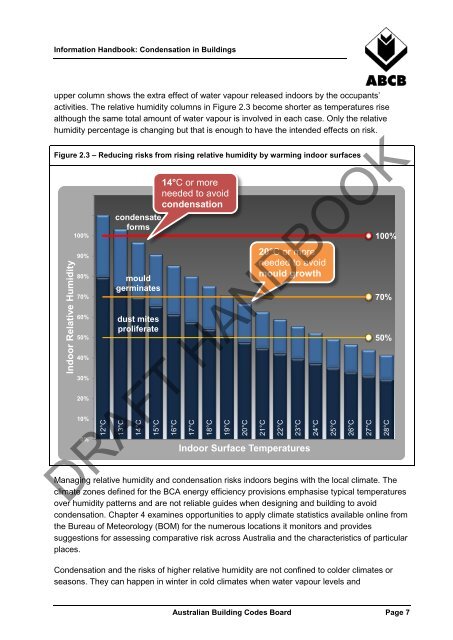Condensation in Buildings - Australian Building Codes Board
Condensation in Buildings - Australian Building Codes Board
Condensation in Buildings - Australian Building Codes Board
Create successful ePaper yourself
Turn your PDF publications into a flip-book with our unique Google optimized e-Paper software.
Information Handbook: <strong>Condensation</strong> <strong>in</strong> Build<strong>in</strong>gs<br />
upper column shows the extra effect of water vapour released <strong>in</strong>doors by the occupants’<br />
activities. The relative humidity columns <strong>in</strong> Figure 2.3 become shorter as temperatures rise<br />
although the same total amount of water vapour is <strong>in</strong>volved <strong>in</strong> each case. Only the relative<br />
humidity percentage is chang<strong>in</strong>g but that is enough to have the <strong>in</strong>tended effects on risk.<br />
Figure 2.3 – Reduc<strong>in</strong>g risks from ris<strong>in</strong>g relative humidity by warm<strong>in</strong>g <strong>in</strong>door surfaces<br />
Indoor Relative Humidity<br />
100%<br />
90%<br />
80%<br />
70%<br />
60%<br />
50%<br />
40%<br />
30%<br />
20%<br />
10%<br />
0%<br />
12°C<br />
14°C or more<br />
needed to avoid<br />
condensation<br />
condensate<br />
forms<br />
mould<br />
germ<strong>in</strong>ates<br />
dust mites<br />
proliferate<br />
13°C<br />
14°C<br />
15°C<br />
16°C<br />
17°C<br />
18°C<br />
19°C<br />
Manag<strong>in</strong>g relative humidity and condensation risks <strong>in</strong>doors beg<strong>in</strong>s with the local climate. The<br />
climate zones def<strong>in</strong>ed for the BCA energy efficiency provisions emphasise typical temperatures<br />
over humidity patterns and are not reliable guides when design<strong>in</strong>g and build<strong>in</strong>g to avoid<br />
condensation. Chapter 4 exam<strong>in</strong>es opportunities to apply climate statistics available onl<strong>in</strong>e from<br />
the Bureau of Meteorology (BOM) for the numerous locations it monitors and provides<br />
suggestions for assess<strong>in</strong>g comparative risk across Australia and the characteristics of particular<br />
places.<br />
<strong>Condensation</strong> and the risks of higher relative humidity are not conf<strong>in</strong>ed to colder climates or<br />
seasons. They can happen <strong>in</strong> w<strong>in</strong>ter <strong>in</strong> cold climates when water vapour levels and<br />
20°C<br />
20°C or more<br />
needed to avoid<br />
mould growth<br />
21°C<br />
22°C<br />
23°C<br />
Indoor Surface Temperatures<br />
24°C<br />
25°C<br />
26°C<br />
27°C<br />
100%<br />
DRAFT HANDBOOK<br />
70%<br />
50%<br />
28°C<br />
<strong>Australian</strong> Build<strong>in</strong>g <strong>Codes</strong> <strong>Board</strong> Page 7
















